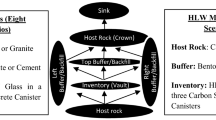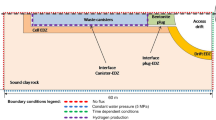Summary
The long-term safety of proposed repositories for nuclear waste is demonstrated by the use of chains of mathematical models describing the performance of the various barriers to radionuclide mobilisation, transport, release into the biosphere and eventual uptake by man. Microbial contamination of such repositories is to be expected, and hence the extent and consequences of microbial activity must also be quantified. This paper describes a modelling approach to determine the maximum microbial activity in the near field of a repository, which can thus be related to maximum possible degradation of performance. The approach is illustrated by application to a proposed Swiss repository for low- and intermediate-level waste (L/ILW), which is immobilised in concrete and emplaced in a marl host rock.
Similar content being viewed by others
References
Grogan, H. A., and McKinley, I. G., An Approach to Microbiological Modelling — Application to the Near Field of a Swiss Low/Intermediate-Level Waste Repository, Nagra Technical Report series NTB 89-06, 1990.
Knecht, B., McKinley, I. G., and Zuidema, P., Disposal of low- and intermediate-level waste in Switzerland: Basic aspects of potential relevance to microbial effects. Experientia46 (1990) 787–791.
McCarty, P. L., Energetics and bacterial growth in: Intern. Proc. 5th Conf. Organic Compounds in the Aquatic environment, pp. 495–531. Ed. F. J. Faust. Marcel Dekker Inc., New York, 1971.
McKinley, I. G., West, J. M. and Grogan, H. A., An Analytical Overview of the Consequences of Microbial Activity in a Swiss HLW Repository, Nagra Technical Report series, NTB 85-43, Nagra, Baden, Switzerland, 1985.
Nagra: Projekt Gewähr 1985; Nagra Feasibility Study, NGB 85-01-NGB 85-08 (in German) and NGB 85-09 (English summary), Nagra, Baden, Switzerland, 1985.
Stanier, R. W., Adelberg, E. A., and Ingraham, J. C., General Microbiology; MacMillan, London 1977.
Thauer, R. K., Jungermann, K., and Decker, K., Energy conservatism in chemotrophic anaerobic bacteria. Bact. Rev.41 (1977) 100–180.
Thauer, R. K. and Morris, J. G., Metabolism of chemotrophic anaerobes: old views and new aspects, in: The Microbe 1984, part II pp. 123–168. Eds D. P. Kelly and N. G. Carr. Cambridge Univ. Press, 1985.
West, J. M., McKinley, I. G., and Chapman, N. A., Microbes in deep geological systems and their possible influence on radioactive waste disposal. Radioact. Waste Manag. nucl. Fuel Cycle3 (1982) 1–15.
West, J. M., Christofi, N., and McKinley, I. G., An overview of recent microbiological research relevant to geological disposal of nuclear waste. Radioact. Waste Manag. nucl. Fuel Cycle6 (1984) 79–95.
Author information
Authors and Affiliations
Rights and permissions
About this article
Cite this article
McKinley, I.G., Grogan, H.A. Consideration of microbiology in modelling the near field of a L/ILW repository. Experientia 47, 573–577 (1991). https://doi.org/10.1007/BF01949879
Published:
Issue Date:
DOI: https://doi.org/10.1007/BF01949879




